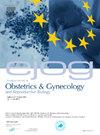Respiratory distress after planned births compared to expectant management – Target trial emulation
IF 2.1
4区 医学
Q2 OBSTETRICS & GYNECOLOGY
European journal of obstetrics, gynecology, and reproductive biology
Pub Date : 2025-02-10
DOI:10.1016/j.ejogrb.2025.02.012
引用次数: 0
Abstract
Objective
The primary aim of this study was to determine the appropriate gestational age for planned births by elective cesarean section (ECS) or induction of labor (IOL) in relation to no excess risk of neonatal respiratory distress.
Study design
Register-based Swedish cohort study including 575,817 singleton live births at 36 weeks or later. Births not eligible for vaginal delivery, preterm premature rupture of membranes and infants with congenital anomalies were excluded. The primary outcome was respiratory distress, and a secondary outcome was Apgar score <7 at five minutes. The risk of outcomes according to onset of birth was calculated for each day from gestational week 36 to 41 and compared with expectant management (EM), defined as births at least one day later.
Results
No excess risk of respiratory distress was found for ECS from 40 weeks and for IOL from 38 weeks compared with EM. At 37 weeks, the absolute risk of respiratory distress was 12.4 % for ECS (aRR:5.7; 95 %CI:4.8; 6.5) and 4.0 % for IOL (aRR:1.7; 95 %CI:1.5; 2.0). At 39 weeks, the absolute risk of respiratory distress for ECS was 3.2 % (aRR:1.6; 95 %CI:1.3; 1.8) whereas the risk was reduced for IOL. ECS <38 weeks increased the risk of Apgar <7 compared with EM.
Conclusion
Regarding neonatal respiratory distress, IOL was safe from 38 weeks and ECS from 40 weeks. At earlier gestational ages, the risk of respiratory distress was significantly higher, which highlights the importance of clear health policies regarding appropriate timing and indications for planned births by ECS and IOL.
求助全文
约1分钟内获得全文
求助全文
来源期刊
CiteScore
4.60
自引率
3.80%
发文量
898
审稿时长
8.3 weeks
期刊介绍:
The European Journal of Obstetrics & Gynecology and Reproductive Biology is the leading general clinical journal covering the continent. It publishes peer reviewed original research articles, as well as a wide range of news, book reviews, biographical, historical and educational articles and a lively correspondence section. Fields covered include obstetrics, prenatal diagnosis, maternal-fetal medicine, perinatology, general gynecology, gynecologic oncology, uro-gynecology, reproductive medicine, infertility, reproductive endocrinology, sexual medicine and reproductive ethics. The European Journal of Obstetrics & Gynecology and Reproductive Biology provides a forum for scientific and clinical professional communication in obstetrics and gynecology throughout Europe and the world.

 求助内容:
求助内容: 应助结果提醒方式:
应助结果提醒方式:


